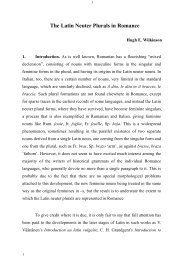THE STRONG PERFECTS IN THE ROMANCE ... - Page ON
THE STRONG PERFECTS IN THE ROMANCE ... - Page ON
THE STRONG PERFECTS IN THE ROMANCE ... - Page ON
Create successful ePaper yourself
Turn your PDF publications into a flip-book with our unique Google optimized e-Paper software.
sight difficult to fit Sp. asir(se) in here because of its single s, though one<br />
could easily imagine the semantic transition from ‘besiege’ (It. assidersi) to<br />
‘seize’. However, Pellegrini (Sp., 147:5) quotes old subj. forms assa, assas,<br />
so it may be possible that there was an old *assir < assīdĕre which was<br />
changed to asir through contamination with asa ‘handle’; this would also<br />
account for its being a primary verb and not changing to *asecer. (We<br />
might even hazard that asgo, asga started out as *assio, *assia, which then<br />
followed the process that turned *tenyo, *tenya into tengo, tenga; cf. the<br />
consonant combination in plazgo, plazga, yazgo, yazga.) I am not happy<br />
with Malkiel’s suggested derivation from *ansire, based on ansa ‘handle’,<br />
as I would then expect it to have the meaning ‘equip with handles’; the<br />
excuse put forward in support of this derivation is that a formation such as<br />
*ansare would have been liable to confusion with the verb for ‘roast’, but<br />
in old Spanish the latter was spelt assar, cf. assadas, L.B.A. 1385c; note<br />
that Portuguese has asado ‘having handles or ears’, kept distinct from<br />
assado ‘roasted’. In French it will be noticed that -s- forms, as sesis, are<br />
also found analogically in vesimes, enchesest (based on similar forms in<br />
other verbs which are found with and without -s-, cf. §§21, 28, 30, 31), and<br />
that all four verbs also have p.ps. in -eit, usually in the East and North-East.<br />
These p.ps. Fouché (§193) explains on the analogy of bene(d)ir, bene(d)eit,<br />
based on the similarity between beneïr and the infinitives chaïr/cheïr, seïr,<br />
veïr. Cf. also Prov. cazech. To explain the adoption of sis in French, one<br />
needs to remember that an -ui perfect and -ūtu p.p. for this verb would have<br />
been too much subject to confusion with the perfects and p.ps. of savoir<br />
and suivre. This seems to me one more argument in favour of supposing<br />
that French originally did agree with the other languages in having such<br />
forms, besides the fact that sessus was not a p.p. and only survived in PR as<br />
a noun.<br />
When we look at Provençal and Catalan we find a situation<br />
44









